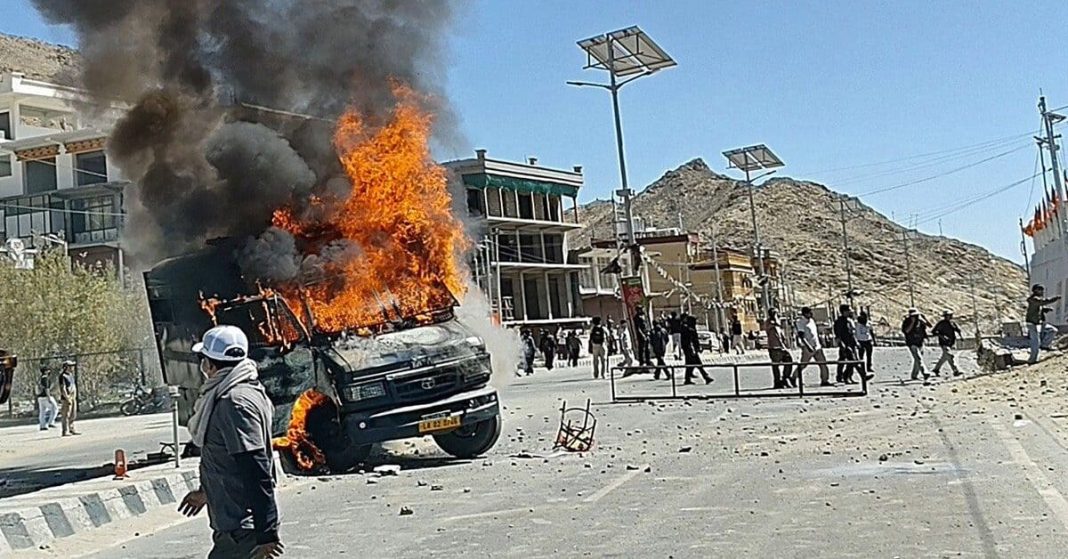At least five people were killed, 30 police officers were injured, and several more protesters calling for statehood were wounded during a protest in India’s Ladakh region on September 24th, Wednesday.
Protests erupted on Wednesday, with crowds demanding greater autonomy in the sparsely populated, high-altitude desert region that is home to some 300,000 people and which borders China and Pakistan.
India’s Ministry of Home Affairs said that an “unruly mob” had attacked police, reporting in a statement issued late on Wednesday that “more than 30” officers were injured.
Protesters torched a police vehicle and the offices of Prime Minister Narendra Modi’s Hindu-nationalist Bharatiya Janata Party (BJP), while officers fired tear gas and used batons to disperse crowds.
“In self-defence, police had to resort to firing, in which, unfortunately, some casualties are reported,” the statement said.
Around half of Ladakh’s residents are Muslim, and about 40 per cent are Buddhist. It is classed as a “Union Territory” — meaning it elects lawmakers to India’s parliament but is governed directly by New Delhi.
Wednesday’s demonstrations were organised in solidarity with prominent activist Sonam Wangchuk, who had been on hunger strike demanding either full federal statehood for Ladakh or constitutional protections for its tribal communities, land, and fragile environment.
New Delhi said the protesters were “instigated by his provocative speeches” and pointed out that efforts were continuing to discuss its governance.
Modi’s government split Ladakh off from India-occupied Kashmir in 2019, imposing direct rule on both. New Delhi has yet to fulfil its promise to include Ladakh in the “Sixth Schedule” of India’s constitution, which allows people to make their own laws and policies.
India’s army maintains a large presence in Ladakh, which includes disputed border areas with China. Troops from the two countries clashed there in 2020, killing at least 20 Indian and four Chinese soldiers.
Union Territory Status and Political Vacuum Fuel Discontent
The Wednesday protest followed the two weeks of demonstrations, demanding statehood for Ladakh with the Indian government and calling for the central government to advance talks on the extension of the Sixth Schedule. The Sixth Schedule protects tribal areas and allows the greater say of the local communities in the governance of their specific region. Ladakh has been protesting for statehood for the past three years.
The region was carved out as a separate Union Territory in 2019 following the abrogation of Article 370 and the bifurcation of J&K. Ladakh has no Assembly, unlike IIOJK, and it is directly governed by the Central Government of India through a Lieutenant Governor. Locals believe that the absence of an Assembly in the region has created a political vacuum. Thus weakening their power to govern themselves and protect their land and job rights. Residents argue that it has also eroded the employment opportunities and land protection as well. These resentments led to large-scale protests and hunger strikes.
Amit Shah must resign because he failed to maintain peace in Ladakh if not lacked ability to do good duty https://t.co/DBCNQDtCO0
— Subramanian Swamy (@Swamy39) September 25, 2025
Political and religious groups from the world’s Buddhist and Muslim majority Kargil joint forces under a joint platform. The Leh Apex body and the Kargil Democratic Alliance, in their joint call for statehood. However, the government has been consistently resisting the call for statehood and the strict schedule for Ladakh, primarily due to its geostrategic location- on the Line of Actual Control with China and the Line of Control with Pakistan, the region is considered a high security zone.
Read more: Pakistan–Saudi Defence Agreement: Strategic Shield or Double-Edged Cold War Replay?
Geopolitical Stakes: Ladakh on the Frontlines with China and Pakistan
Its Union Territory status allows for quick decision-making on military deployments and strategic projects, like the ongoing China-India standoff since the 2020 Galwan Clash.
Protesters bring down the BJP flag from the party headquarter in Leh #ladakh pic.twitter.com/fPnktYH0mk
— Jehangir Ali (@Gaamuk) September 24, 2025
Ladakh’s difficult terrain, which includes high-altitude deserts, rugged valleys, steep passes, and extreme weather, makes infrastructure and development work extremely difficult. Development requires heavy machinery, specialized expertise, and large financial support. Resources that the only central government can provide.
In recent years, the Home Affairs of India has set up a high-powered committee to address the concerns of the people of Ladakh. Discussing job quotas and increased parliamentary representation, the government has nearly dismissed the calls for statehood and Sixth Schedule as non-starters. Talks that started in 2024 but failed with another round expected on October 6. The Central Government may consider expanding the powers of Ladakh to grant locals more control over their region. However, demands for statehood are still unlikely to be met despite growing frustrations in the local community.
With Additional Input from GVS South Asia Desk














